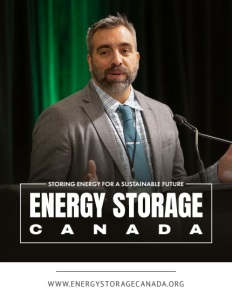Storing Energy for a Sustainable Future
Leading the industry path through policy development, advocacy, research and education
Energy Storage Canada is Canada’s trade association for energy storage. We are a national non-profit organization, and our goal is to work with our 100-plus members to lead the growth and market development of the energy storage sector across the country through policy development, government advocacy, education, and research. We are technology agnostic, and support all types and durations of storage, from EVs and residential storage, to grid-scale installations like lithium-ion battery energy storage systems (BESS) or traditional pumped hydro.
As the world’s energy systems undergo substantial adjustments to meet the changing and increasing demand, energy storage is a critical tool for system operators to ensure flexible, reliable, and affordable energy is available to ratepayers. The International Energy Agency’s (IEA) 2024 World Energy Outlook indicated the world needs to “massively increase its energy storage capacity” in the coming years, indicating energy storage resources will be a “key source of dispatchable capacity globally.”
Established energy storage technologies, such as lithium-ion BESS have reached their lowest price-point since 2017, dropping to $115 per kilowatt hour (KWh). Scores of emerging storage technologies are transitioning from pilot projects to large-scale deployments, rapidly increasing the diverse array of storage solutions for grid operators. In 2023, the global energy storage market nearly tripled and the energy storage market is expected to grow 15-fold by 2030, with the IEA projecting that energy storage could meet up to 40% of short-term electricity flexibility up to 2050.
Canada is experiencing similar fluctuations and increases in energy demand across the country, spurred by a range of factors including ambitious decarbonization goals at the national and provincial levels, significant demand growth, and reduced costs for renewables and energy storage technologies.
Our mandate, as an organization, is to support the development of energy storage where it can serve as a solution for the uncertainties and changes Canada’s electricity grids are experiencing. Because energy storage encompasses a wide range of technologies, it’s an incredibly versatile solution that can contribute diverse benefits to the grid.
At a basic level energy storage technologies shift energy from a time when it is not needed to a time when it is. Storage can shift energy from second to second to ensure stable electricity flow to sensitive assets or technologies, over the course of minutes, during hours of peak energy demand, or from the day time when renewable energy assets are generating more than is needed, to evening, when the sun goes down. However, the ability to store energy and feed it back to the grid only scratches the surface of the potential these technologies can contribute.

Energy storage can optimize any type of generation, to maximize the efficiency of the electricity generated, enhancing clean generation, supporting decarbonization, and increasing cost effectiveness for ratepayers. Energy storage can provide regional support, reducing system costs by delaying or preventing the need for large-scale transmission or distribution infrastructure, such as peaker plants, to meet demand surges. Storage increases self-sufficiency, by optimizing the assets in the grid and reducing reliance on imported energy, as well as providing resilience in the face of natural disasters. In remote communities, energy storage can enhance local renewable generation, reducing dependence on diesel generators, and providing more reliable electricity supply to those in the community.
The flexibility and scalability of energy storage technologies further enhance its value. From electric vehicle (EV) batteries to residential storage systems and large-scale grid projects, energy storage serves a wide range of applications. Distributed Energy Resources (DERs) like EV batteries or residential storage systems can help communities optimize local energy generation, providing even more tailored, resilient solutions. Energy storage systems can be deployed quickly and adapted to the specific needs and environments of different regions, making them a versatile tool in the transition to a sustainable and reliable energy grid.
However, the introduction of any new technology into an established system presents challenges and opportunities. Energy storage is no exception. Above I detailed several of the opportunities these technologies present in terms of securing more affordable, sustainable, reliable energy for Canadian communities. Moreover, the leadership Canada has shown in the industry provides a substantial economic opportunity, through Canada’s diverse natural resources, new manufacturing, and employment. To capitalize on these opportunities, it will be critical to tackle a few key challenges.

First, it is important that governments, regulators, and system operators are informed about the potential of storage and that they understand the importance of modernizing the regulatory environment to ensure its integration. This goes hand in hand with ensuring governments continue to provide mechanisms to support the development of the nascent industry, through policy, but also through programs such as the current Federal Investment Tax Credits (ITCs), which support storage development at the grid level, as well as manufacturing.
Second, it will be important to ensure a reliable and stable supply chain for the varied components and natural resources required to manufacture energy storage systems. As an emerging industry, these supply chains are in the process of being established and need concentrated support to ensure the development of a robust range of suppliers for the components and supplies these systems require. It is essential for Canada’s industry to remain competitive.
Where possible, the development of domestic supply provides an opportunity for Canada to further establish itself as a leader in the sector. However, it is also important to protect trade relations with existing partners, for example, by ensuring the expected tariffs with the United States have minimal impact on the energy storage supply chain. As well, that any restrictions on imports from China are focused on targeting exclusively the components presenting risk to Canadian systems, while preserving trade related to components presenting minimal risk that are critical to maintaining Canada’s competitive advantage.
While these challenges do need to be addressed, it is well within the scope of the industry, working with governments, regulators, system operators, First Nations, and municipalities to find productive resolutions that will enhance and sustain Canada’s energy storage industry. As Canada’s national trade association for energy storage, this is one of our key objectives and we are consistently encouraged by the conversations we have across the country every day. We look forward to the future of Canada’s energy storage industry and to the critical role storage will play in Canada’s future grid.
AT A GLANCE
Who: Energy Storage Canada
What: The leading trade organization representing its 100 plus industry members through advocacy, education and policy direction
Where: Toronto, Ontario
Website: www.energystoragecanada.org


